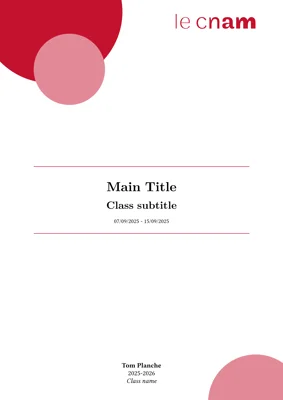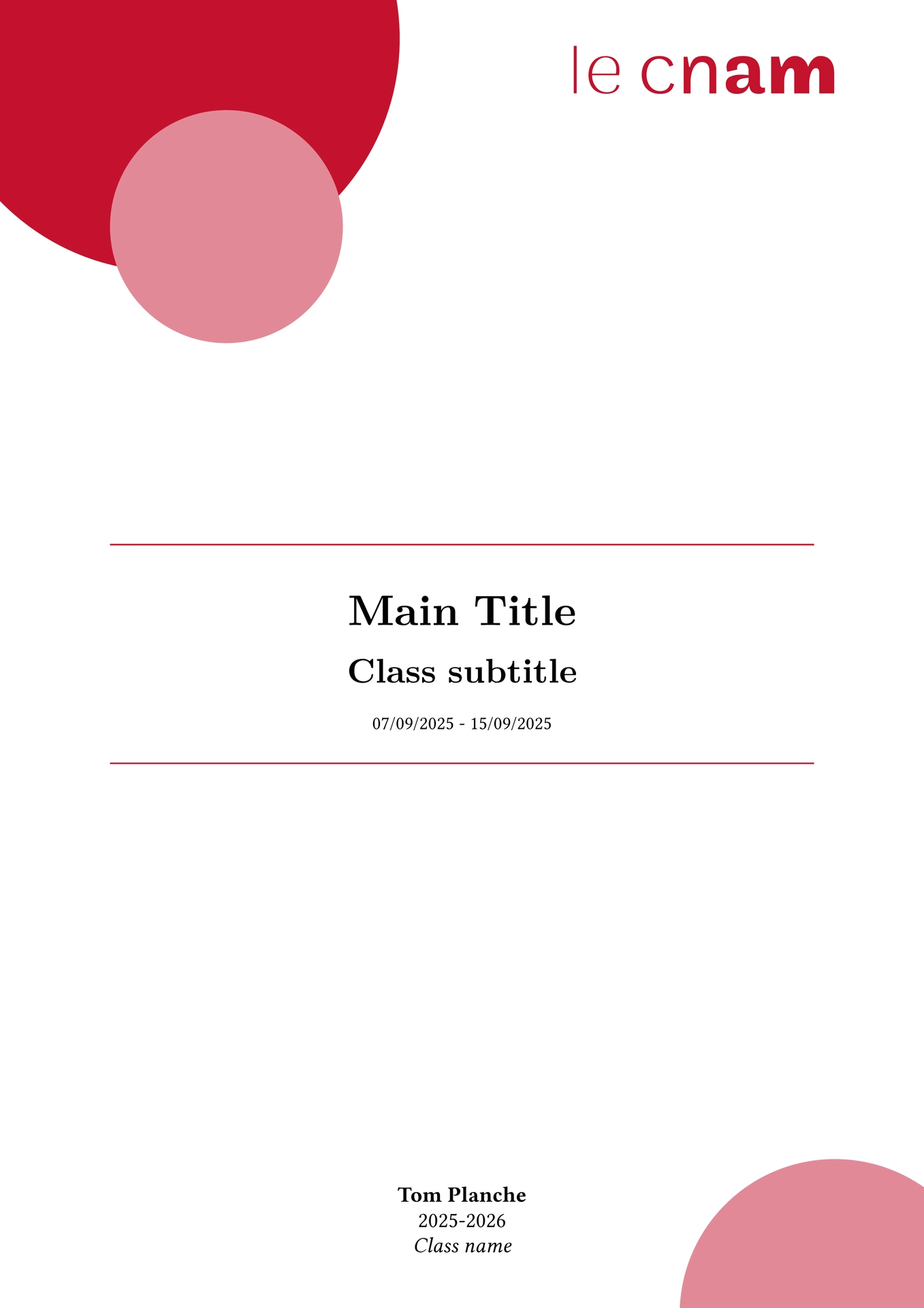A modular and organized TYPST template for creating professional documents using CNAM branding and styling.
Originally based on hzkonor’s bubble-template and uses CNAM’s logo and colors.
Dependencies
This template uses the following external packages:
@preview/great-theorems:0.1.2- Mathematical theorem environments@preview/headcount:0.1.0- Counter management@preview/hydra:0.6.2- Intelligent page headers with section awareness@preview/i-figured:0.2.4- Figure and equation numbering
Project Structure
├── src/
│ ├── lib/ # Template library files
│ │ ├── config.typ # Main configuration and document setup
│ │ ├── fonts.typ # Centralized font configuration
│ │ ├── components.typ # UI components (blockquote, my-block, code)
│ │ ├── headers.typ # Header management logic
│ │ ├── layout.typ # Document layout and styling
│ │ ├── utils.typ # Utility functions
│ │ ├── colors.typ # Color definitions
│ │ └── math.typ # Mathematical environments
│ └── lib.typ # Main package entrypoint (local import)
├── template/
│ └── assets/ # Static assets (logos, images)
│ └── cnam_logo.svg # CNAM logo
├── main.typ # Example document using the published package
└── README.md
Features
- Modular Design: Template split into logical, maintainable modules
- CNAM Branding: Official CNAM colors and styling
- Centralized Font Configuration: Global font settings for consistency
- Enhanced Code Blocks: Syntax highlighting, line numbers, filename labels
- Rich Components: Custom blockquotes, styled content blocks
- Math Support: Mathematical definitions, theorems, examples
- Smart Headers: Context-aware page headers
- Responsive Layout: Professional document layout with decorative elements
Usage
Basic Usage
-
Import the template in your document:
- Using the published package (as in
main.typ):
#import "@preview/clean-cnam-template:1.4.0": *- Using this repository locally (from
src/):
#import "src/lib.typ": * - Using the published package (as in
-
Configure your document with basic parameters:
#show: clean-cnam-template.with(
title: "Your Title",
author: "Your Name",
class: "Course Name",
subtitle: "Subtitle",
// If using the package, point to your own copy of the logo
// If using this repo locally, you can use the provided logo path
logo: image("template/assets/cnam_logo.svg"),
start-date: datetime(day: 4, month: 9, year: 2024),
main-color: "#C4122E", // Custom color (default is "E94845")
default-font: "New Computer Modern Math",
code-font: "Zed Plex Mono",
)
- Write your content using the available components and styling.
Complete Parameter Reference
The clean-cnam-template function accepts the following parameters:
| Parameter | Type | Default | Description |
|---|---|---|---|
title |
string | "" |
Document title |
subtitle |
string | "" |
Document subtitle |
author |
string | "" |
Author name |
affiliation |
string | "" |
Author’s affiliation/institution |
year |
int | current year | Year for school year calculation |
class |
string/none | none |
Class/course name |
start-date |
datetime | today | Document start date |
last-updated-date |
datetime | today | Last updated date |
logo |
image/none | none |
Logo image to display |
main-color |
string | "E94845" |
Primary color (hex string) |
color-words |
array | () |
Words to highlight with primary color |
default-font |
string | "New Computer Modern Math" |
Body text font |
code-font |
string | "Zed Plex Mono" |
Code block font |
show-secondary-header |
bool | true |
Show secondary headers |
outline-code |
content/bool/none | none |
Custom outline configuration |
Advanced Configuration
Font Configuration
The template includes centralized font management that allows you to set consistent fonts across your document:
#show: clean-cnam-template.with(
default-font: "Inter", // Sets body text font
code-font: "JetBrains Mono", // Sets code block font
// ... other parameters
)
All code blocks and monospace text will automatically use the configured code-font, while body text uses the default-font.
Color Highlighting
You can automatically highlight specific words throughout your document with the primary color:
#show: clean-cnam-template.with(
// ... other parameters
color-words: ("important", "CNAM", "theorem"),
main-color: "#C4122E",
)
Any occurrence of the specified words will be rendered in the main-color.
Header Configuration
Control the display of secondary headers (sub-headings in page headers):
#show: clean-cnam-template.with(
// ... other parameters
show-secondary-header: false, // Only show main section in headers
)
Date Range Display
The template automatically formats date ranges. If start-date and last-updated-date are the same, only one date is shown. Otherwise, both dates are displayed as a range:
#show: clean-cnam-template.with(
start-date: datetime(day: 1, month: 9, year: 2024),
last-updated-date: datetime(day: 15, month: 12, year: 2024),
// Displays: 01/09/2024 - 15/12/2024
)
Custom Outline
The template allows you to customize or disable the table of contents (outline) on the title page:
Default Outline
#show: clean-cnam-template.with(
// ... other parameters
// outline-code: none, // This is the default - standard outline
)
Custom Outline
You can provide your own outline configuration:
#show: clean-cnam-template.with(
// ... other parameters
outline-code: outline(
title: "Table des matières",
depth: 2,
indent: auto,
),
)
Disable Outline
To disable the outline completely:
#show: clean-cnam-template.with(
// ... other parameters
outline-code: false,
)
Code Blocks
The template provides enhanced code blocks with multiple features including syntax highlighting, line numbers, and filename labels.
Note: Examples below use text fences and Typst raw(...) to avoid nested backticks so automated package checks pass. In your own documents, you can use normal Markdown code fences and standard Typst code blocks.
Basic Usage
#code(
lang: "Python",
raw(block: true, lang: "python", "def hello_world():\n print(\"Hello, World!\")")
)
With Filename
#code(
filename: "main.py",
lang: "Python",
raw(block: true, lang: "python", "def hello_world():\n print(\"Hello, World!\")")
)
Advanced Options
The code() function supports many customization options:
| Parameter | Type | Default | Description |
|---|---|---|---|
lang |
string/none | none |
Programming language for syntax highlighting |
filename |
string/none | none |
Optional filename to display |
numbering |
bool | true |
Whether to show line numbers |
line-spacing |
length | 5pt |
Vertical spacing between lines |
fill |
color | luma(250) |
Background color |
stroke |
stroke | 1pt + luma(180) |
Border style |
radius |
length | 3pt |
Border radius |
width |
length/% | 100% |
Block width |
lines |
range/auto | auto |
Line range to display |
number-align |
alignment | right |
Line number alignment |
text-style |
dict | (size: 8pt) |
Text styling options |
Example with custom styling:
#code(
numbering: false,
fill: rgb("#f8f8f8"),
stroke: 2pt + rgb("#e0e0e0"),
radius: 5pt,
lang: "Rust",
raw(block: true, lang: "rust", "fn main() {\n println!(\\\"Hello, world!\\\");\n}")
)
Components
UI Components
blockquote()
Styled quote blocks with customizable colors and borders.
Parameters:
color: Stroke color (default:luma(170))fill: Background color (default:luma(230))inset: Padding (default: custom spacing)radius: Border radius (default: rounded right side)stroke: Stroke configuration (default: left border only)
Example:
#blockquote[
This is an important quote that needs highlighting.
]
my-block()
Custom content blocks with configurable styling.
Parameters:
fill: Background color (default:luma(230))inset: Padding (default:15pt)radius: Border radius (default:4pt)outline: Border stroke (default:none)alignment: Block alignment (default:center)
Example:
#my-block(fill: rgb("#e3f2fd"))[
Important note or callout content.
]
code()
Enhanced code blocks with line numbers, syntax highlighting, and filename labels. See the Code Blocks section for detailed documentation.
Math Components
definition()
Mathematical definition blocks with red styling.
Example:
#definition(title: "Derivative")[
The derivative of a function $f$ at point $a$ is defined as...
]
example()
Example blocks with blue styling.
Example:
#example(title: "Computing a limit")[
Calculate: $lim_(x -> 0) sin(x)/x = 1$
]
theorem()
Theorem blocks with purple styling.
Example:
#theorem(title: "Pythagorean Theorem")[
For a right triangle: $a^2 + b^2 = c^2$
]
Utilities
ar(name)
Creates vector arrow notation in math mode.
Example:
$ar(v) = (x, y, z)$
icon(codepoint)
Displays an icon with proper sizing and spacing for inline use.
Example:
#icon("path/to/icon.svg") Inline text with icon
date-format(date)
Formats a datetime object to French format (DD/MM/YYYY).
Example:
#date-format(datetime(day: 4, month: 9, year: 2024))
// Outputs: 04/09/2024
Recent Updates
v1.3.0 - Header and Heading Improvements (Latest)
- New header system: Integrated hydra for intelligent section-aware page headers
- Enhanced chapter styling: Redesigned level 1 headings with centered layout, “Chapter N” prefix, and decorative lines
- Fixed heading numbering: Sub-headings now only display their relevant numbers (e.g., “I -” instead of “III I -”)
- New utility: Added
thin-linefor consistent decorative elements
v1.2.0 - Component Customization
- Blockquote enhancements: Border side selection, attribution support, alignment options
- my-block improvements: Title support, flexible alignment, width control
- Code component updates: Title parameter, enhanced styling options
- Math components: Full customization for definition, example, and theorem blocks
Previous Updates
Font Configuration System
- Added centralized font management with
default-fontandcode-fontparameters - Created separate
fonts.typmodule to avoid circular dependencies - All components now use consistent font configuration
Enhanced Code Blocks
- Added optional
filenameparameter for code blocks - Language labels now appear above code blocks instead of inline
- Improved visual connection between filename/language labels and code content
- Fixed font inheritance issues with proper context handling
Improved Modularity
- Restructured imports to eliminate circular dependencies
- Added
lib.typas main package entrypoint - Better separation of concerns across modules
Author
- Tom Planche
License
MIT

